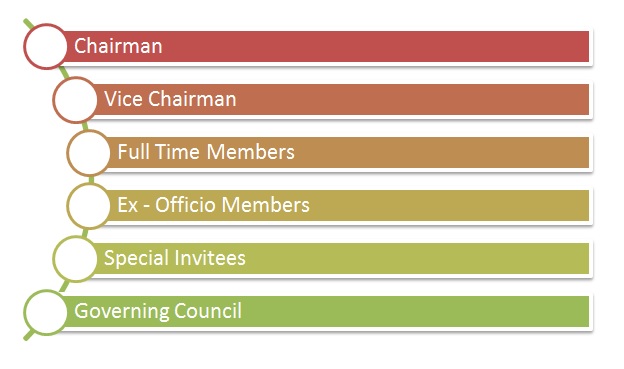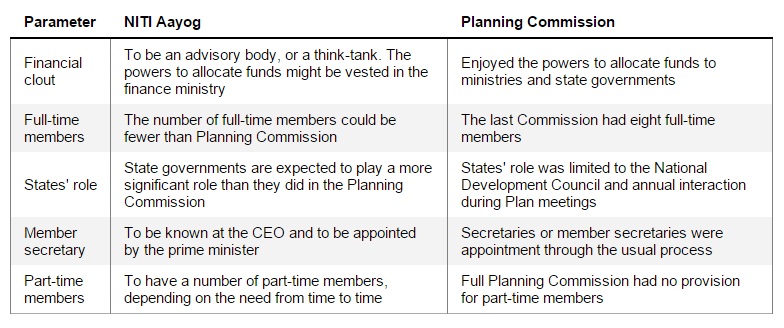The National Institution for Transforming India Aayog, or NITI Aayog, is a Government of India policy think-tank established by Prime Minister Narendra Modi to replace the Planning Commission.
Formed: January 1, 2015
NITI Aayog seeks to facilitate and empower the critical requirement of good governance, which is people-centric, participative, collaborative, transparent and policy-driven. It will provide critical directional and strategic input to the development process, focusing on deliverables and outcomes. This, along with being as incubator and disseminator of fresh thought and ideas for development, is the core mission of NITI Aayog.
– mygov.in
Constitution of NITI Aayog and its members
The NITI Aayog comprises the following:
# Prime Minister of India as the Chairperson
# Governing Council comprising the Chief Ministers of all the States and Union territories with Legislatures and lieutenant governors of other Union Territories.
# Regional Councils will be formed to address specific issues and contingencies impacting more than one state or a region. These will be formed for a specified tenure. The Regional Councils will be convened by the Prime Minister and will be composed of the Chief Ministers of States and Lt. Governors of Union Territories in the region. These will be chaired by the Chairperson of the NITI Aayog or his nominee
# Experts, specialists and practitioners with relevant domain knowledge as special invitees nominated by the Prime Minister
# Full-time organizational framework (in addition to Prime Minister as the Chairperson)
- Vice-Chairperson: Arvind Panagariya
- Members: Three (3) Full-time-
- Economist Bibek Debroy,
- Former DRDO chief V.K. Saraswat and
- Agriculture Expert Professor Ramesh Chand
- Part-time members: Maximum of two from leading universities research organizations and other relevant institutions in an ex-officio capacity. Part-time members will be on a rotational basis
- Ex Officio members: Maximum of four members of the Union Council of Ministers to be nominated by the Prime Minister
- Chief Executive Officer: To be appointed by the Prime Minister for a fixed tenure, in the rank of Secretary to the Government of India. Amithab Kant has been appointed as the new Chief Executive Officer.
- Secretariat as deemed necessary
Role of former Planning Commission
The Planning Commission was set up in the year 1950 by Pandit Jawaharlal Nehru, the first Prime Minister of India, to formulate Five-Year Plans. The main objective was to help in the formulation of policies and creation of a strong Central Government-driven plan that would have great impact on the development of each of the States in the country. Under the Planning Commission or Yojana Aayog, the flow of policy was directed from the Centre to the States and the Union Territories. The Planning Commission was involved in:
>> Assessment of resources of the country – material, capital and human, and making optimum use of the resources and proper formulation of proposals.
>> An effective formulation of the Five-Year Plans for a balanced utilisation of the country’s resources and make each State prosperous.
>> Determination of priorities and allocation of resources.
>> Determination of infrastructure necessary for the successful implementation of the Plan in various stages.
>> Regular checks of the progress achieved at each stage etc.
Difference between NITI Ayog and Planning Commission
The objectives of NITI Aayog
NITI Aayog will have the following objectives:
# To create a vision and plan of national development with the active involvement of the States.
# To develop methods to create credible plans at the village level and later on at higher levels of Government.
# The interests of national security are to be considered in economic strategy and policy.
# To pay attention to the communities of our society that are not adequately benefited from economic progress.
# To design long-term programmes and policies and monitor their progress. Here, time to time monitoring and feedback will become the basis for making the necessary improvements and corrections.
# To encourage participation of key stakeholders, think tanks, educational and policy research institutions.
# To create an innovation, entrepreneur and knowledge support system.
# To offer a common platform for solving any kind of inter-departmental or sectoral issues to speed up the implementation of the development agenda.
# To establish and maintain a sophisticated resource and research centre on good governance and best practices.
# To focus on up-gradation of technology for proper implementation of programmes and initiatives.
************************
References –
The Business Standard
The Business Line
Wikipedia
Articles
We tried to cover NITI Ayog from every corner. Still, it is incomplete without your consent and views. Put your comments under the comment Section below.


















